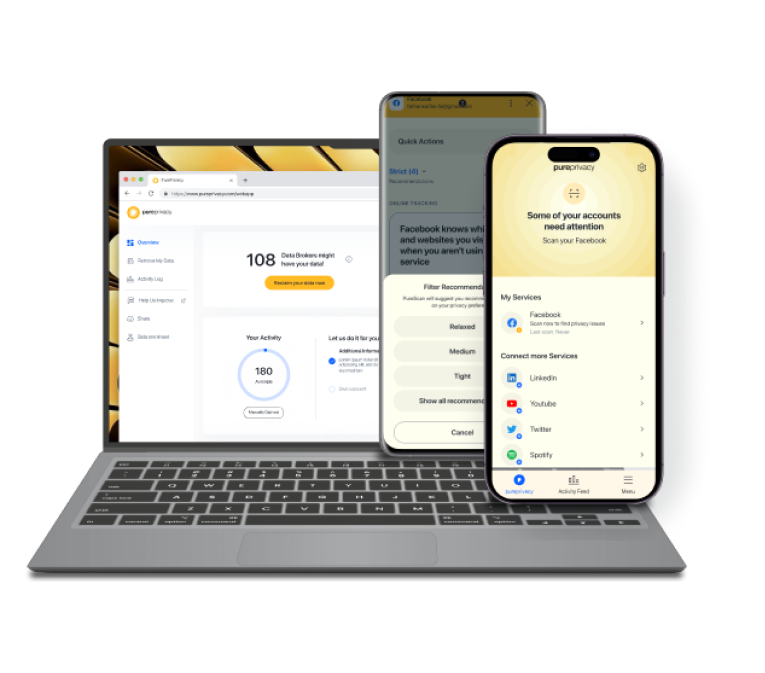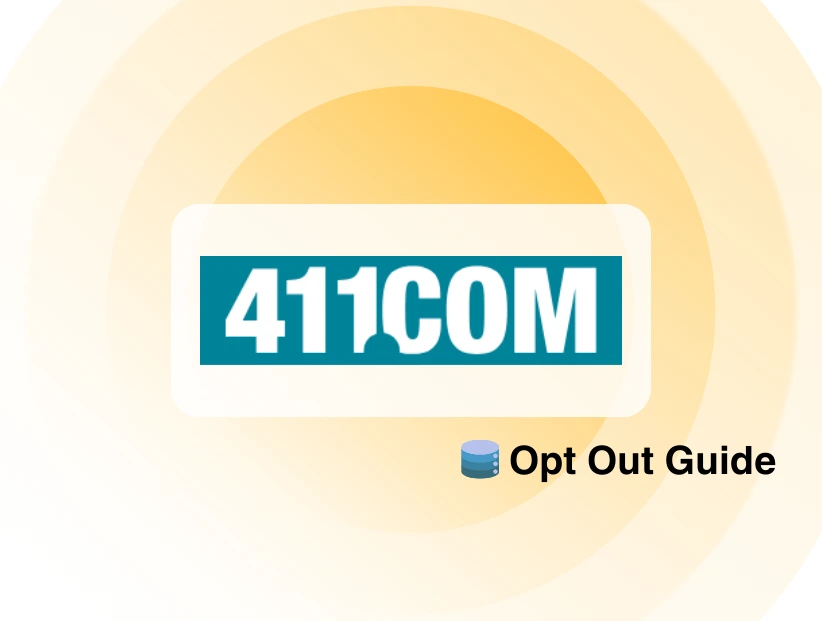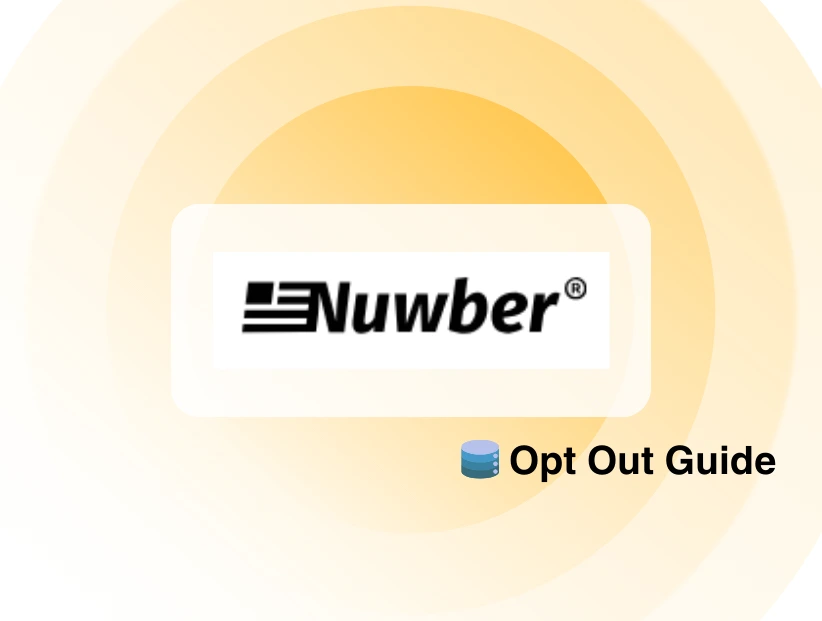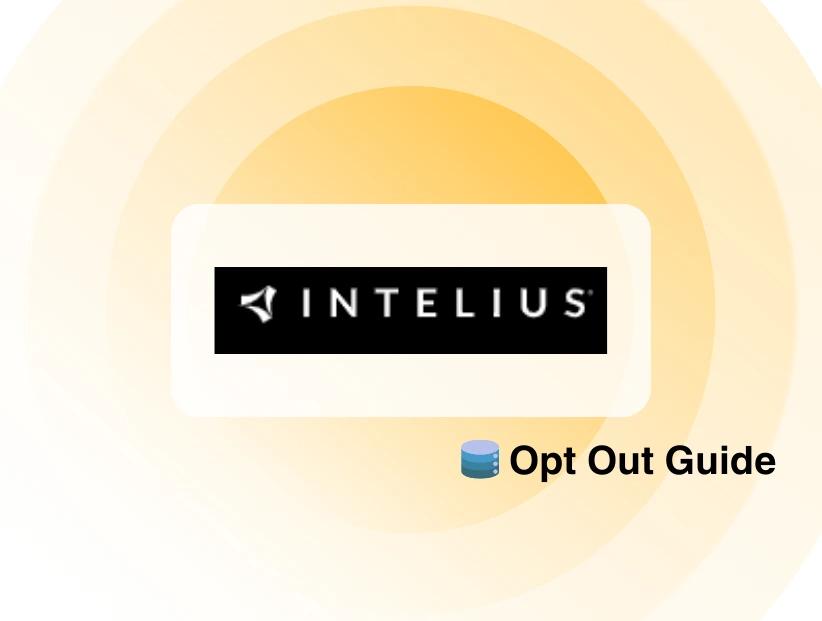Table of Content
- What is OpenAI?
- Why Is It Important to Delete Your Data from OpenAI?
- How Does OpenAI Use Your Data?
- How to Delete Your Data from Open AI
- How to Delete Your Data from Slack
- How to Delete Your Data from Adobe
- How to Delete Data from Google
- Frequently Asked Questions (FAQs)
- Reclaim Optimal Privacy by Deleting Data from AI and Tech Giants
Do you know? Data breaches are becoming a bigger worry as AI grows more integrated into our lives.
In May 2023, an issue in ChatGPT exposed more than 100 million users' conversation history and some payment information (including the last four digits of credit card numbers).
This incident emphasises the value of data control in AI systems.
This blog teaches you how to gain control of your privacy by deleting data from some of the biggest companies in AI and technology, including OpenAI, Slack, Adobe, and Google.
Why Is Data Deletion Crucial?
Data removal is critical for security purposes in AI. AI systems learn and adapt based on the data they analyse; however, the results may be discriminatory or harmful if this data contains sensitive information or errors.
Also, data breaches in AI can be especially dangerous because of the huge amount of information saved and the possibility of unintentional exposure.
Deleting data assists in avoiding these dangers while also complying with certain rules and regulations, such as the General Data Protection Regulation (GDPR) and the California Consumer Privacy Act (CCPA), which require users to control their personal information.
Read through this tweet about why deleting data from AI is necessary:
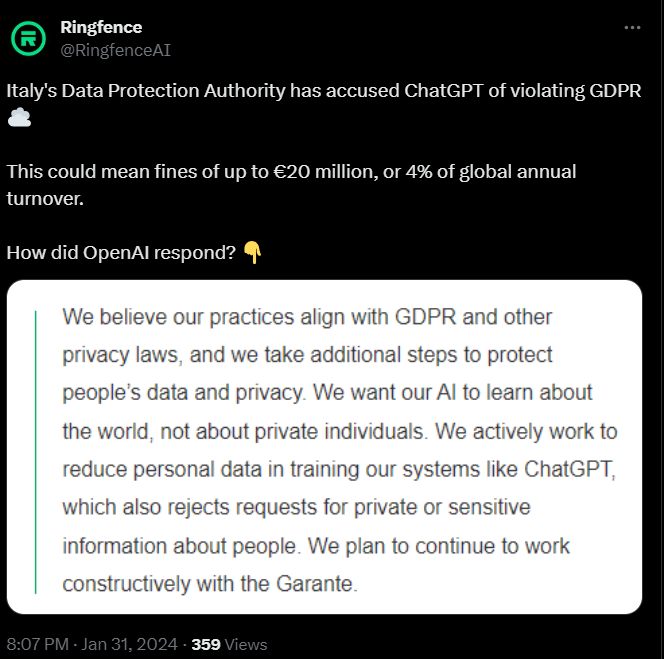
What is OpenAI?
OpenAI is an American artificial intelligence (AI) research organisation created in December 2015.
It aims to develop "safe and beneficial" artificial general intelligence, defined as "highly self-sufficient systems that outperform humans at most economically valuable work."
As a significant organisation in the AI boom, it has created numerous vast language models, effective picture creation models, and previously released open-source models. The release of ChatGPT has been credited with beginning the AI boom.
Why Is It Important to Delete Your Data from OpenAI?
The decision to remove your information from OpenAI is based on your level of security with data privacy. Here's a list of reasons you might want to delete your data:
Safety Challenges
- OpenAI uses data to develop significant language models and strong AI systems.
- While data is anonymized before training, some users may be concerned that their interactions will be utilised this way, even indirectly.
Little Control
- Once you provide data to OpenAI, you have little control over how it is utilised, apart from opting out of training data.
- When you delete your data, you ensure that OpenAI does not use it for any purpose.
Maximising Your Privacy
- The world of AI is constantly changing, and how information is used may change over time.
- Deleting your data guarantees it will not be used in any inappropriate ways in the future.
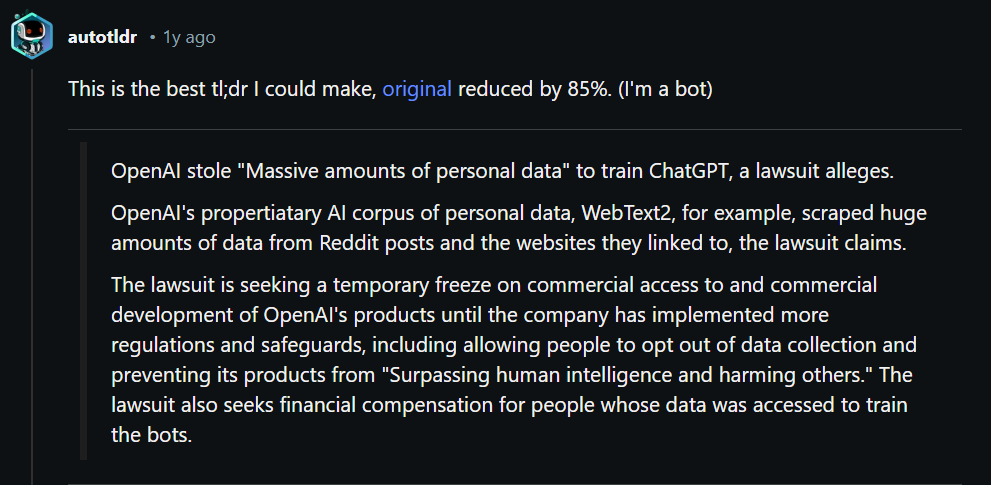
How Does OpenAI Use Your Data?
OpenAI processes your data in two ways, depending on how you engage with it.
Consumer products such as ChatGPT may use your prompts, reactions, and created content (after deleting personally identifiable information) to develop their AI models.
You have the option to opt-out. However, they do use specific, anonymized data for misuse monitoring and keep it for a specific length of time.
How to Delete Your Data from Open AI
There are two ways to remove your data from OpenAI, depending on the kind of data and how you engage with it.
For Your Account Information and Content
- Click this link to log into your ChatGPT account.
- Then proceed to the Settings menu.
- After that, select Data Controls.
- You will see options to disable "Chat History and Training" and "Personalization."
- This blocks companies from using your information to enhance their models and customise your experience.
Delete Data by Submitting Form
- You can opt out of your data being used to train AI models by completing the "User Content opt-out request" online form at https://privacy.openai.com/policies.
- Once you open this link click on the Make a Privacy Request option on the top right corner of the screen.
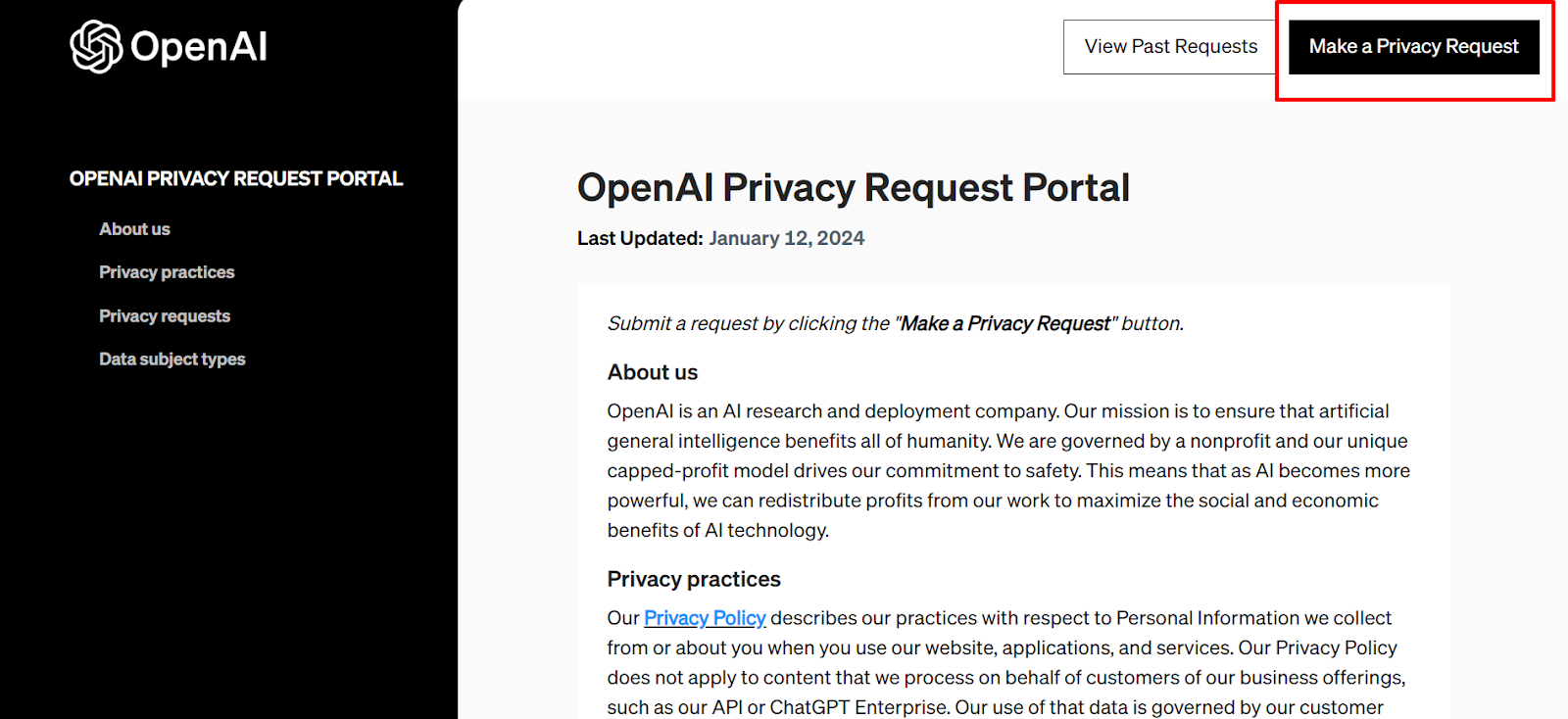
- Then click on the I Have an Open AI Account option from the popup window.

- Then click on the Open AI Personal Data Removal Request option from the popup window.
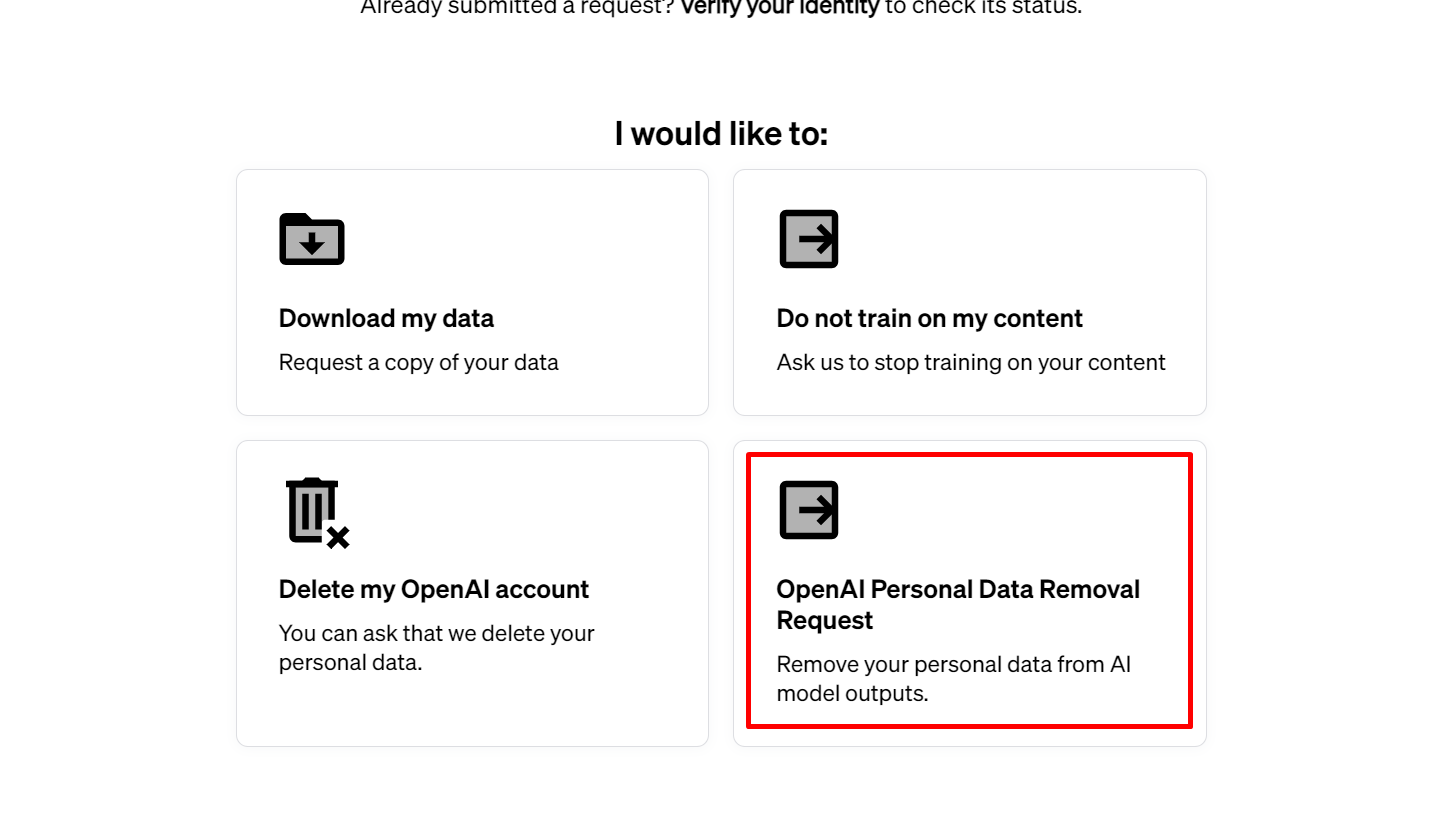
- After that enter your email address on the next popup window and click on the Send Email button.
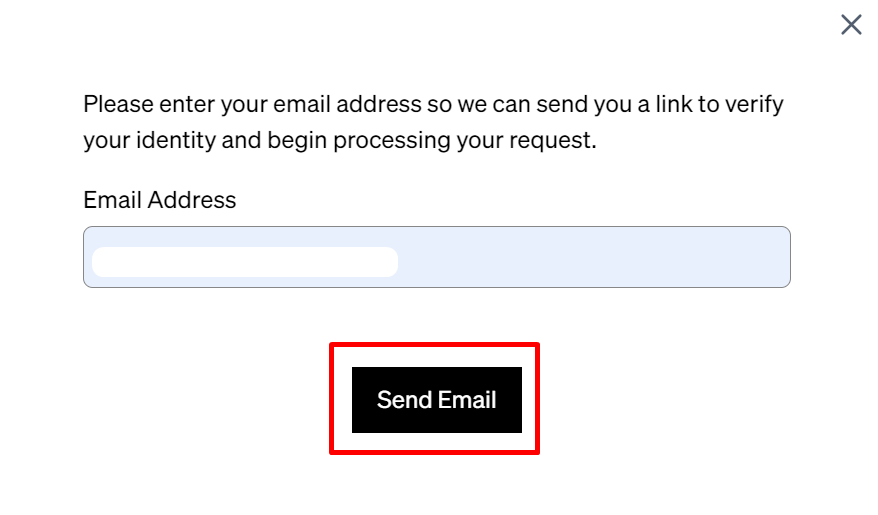
- Then open the email and click on the login button.

- Then, you will see another window that tells you about your rights to submit a request for data removal under the GDPR law.
- Then scroll down, fill out the form with the required details, and click on the Submit Request button.
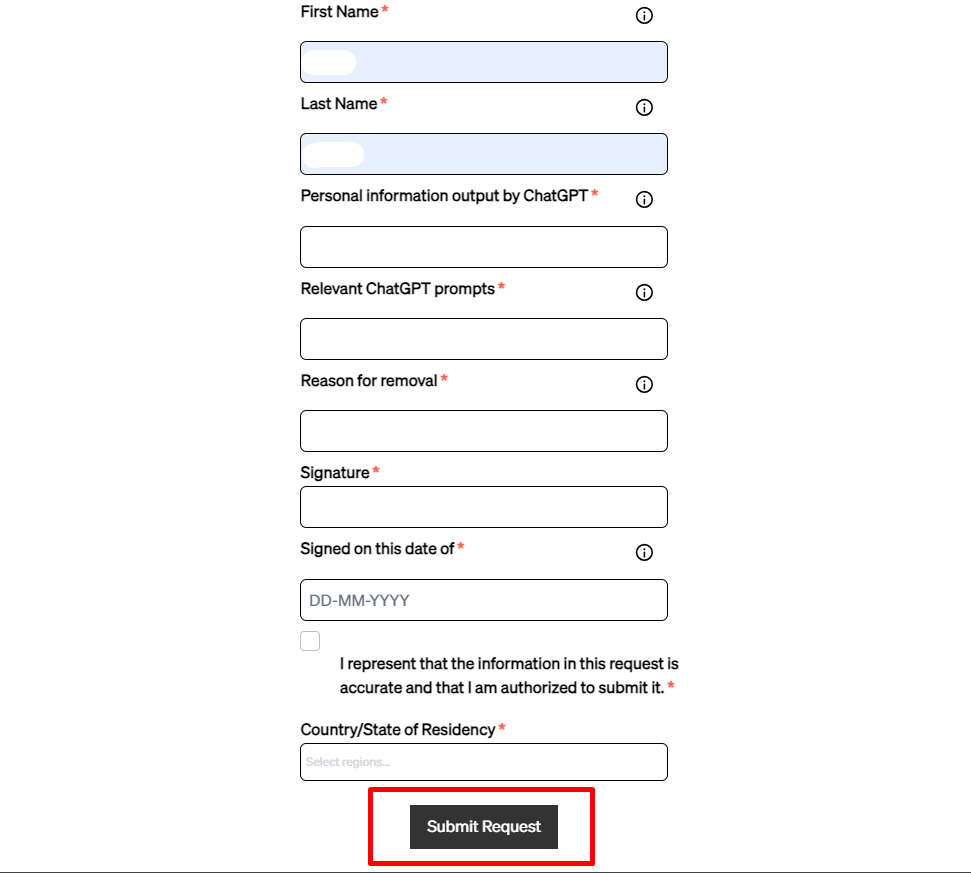
That is it, your request will be processed and your data will be deleted from OpenAI.
You can also use PurePrivacy to manage your OpenAI data security. Its features, such as Tracker Blocker, block OpenAI from collecting data with a device VPN, hence disabling trackers. This disrupts data collection by OpenAI and third parties.
Important Things to Keep In Mind Before Deleting Your Data from OpenAI
Here are some important factors to think about before deleting your data from OpenAI:
Training Benefits
- Deleting your data, particularly chat history, ensures that your interactions will not be utilised to improve future responses for you or others.
- This could result in less customised and potentially inaccurate responses from ChatGPT.
Access to Previous Conversations
- Once deleted you will be unable to access your previous interactions with ChatGPT.
- These could be useful for referencing or reviewing previous conversations.
Anonymized Data
- Even if you remove personally identifying information, OpenAI can keep anonymized information for research or security purposes.
- This anonymized data can be connected back to you in the future as technology advances.
Data Already Used
- There is no certainty that data used to train current models will be removed if you delete your own.
- Your previous interactions may have altered ChatGPT's present capabilities.
Data Controls
- OpenAI provides alternatives such as turning off chat history and opting out of training data utilisation.
- This gives you control over how the data is utilised while avoiding loss.
- These settings are available in your ChatGPT account under "Data Controls."
Account Removal
- Deactivating your account disables the use of your data and prevents further interactions.
- However, depending on OpenAI's policies, some anonymized data may still be stored.
What Is Slack?
Slack is a cloud-based team communication tool created by Slack Technologies and owned by Salesforce since 2020.
Slack offers freemium and premium memberships. Slack's basic user base consists of businesses, and its functions are largely designed for enterprises.
Why Is It Important to Delete Your Data from Slack?
In certain cases, removing your data may be the best option. Here is the breakdown of both sides:
Taking Charge of Your Privacy
- Slack saves many of your business conversations, data, and even previous versions of updated messages.
- If you are no longer a member of a team or project, it may be beneficial to remove the online trace for privacy purposes.
New Beginning
- Perhaps you left a job on not very good terms.
- Deleting your data might be a symbolic new beginning, leaving no online track in that workspace.
Minimise Potential Issues
- You can not control what people say, but you have control over what information you put out there.
- Deleting old messages and data reduces the probability that something unpleasant will resurface later.
Find out by reading people's thoughts if Slack deletes all of your data once the account has been deleted:
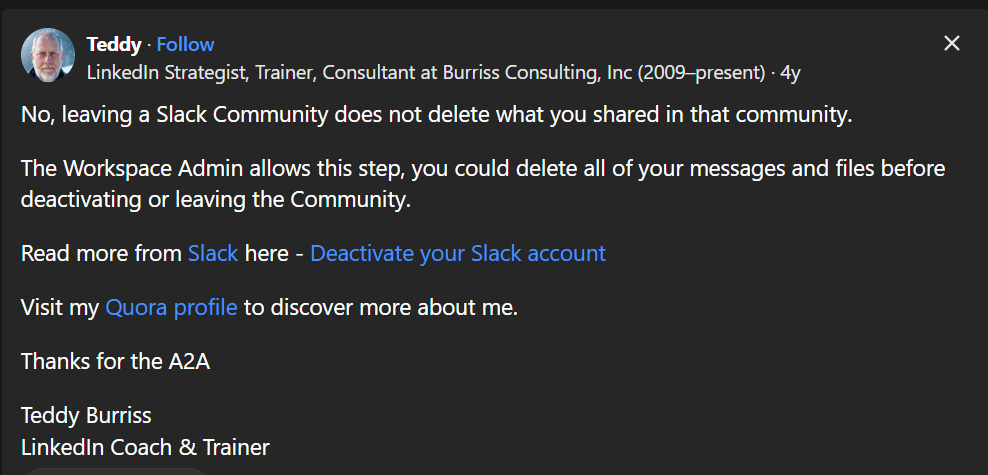
How Does Slack Use Your Data?
Slack uses your data for basic functions like messaging and enhancements, but privacy concerns persist. They use your messages, files, and usage information to provide the service, personalise your experience, and improve the platform.
However, this data can contain private details such as passwords, and fears arise since this data is never removed by default and can be used by hackers via phishing attempts, poor safety measures from third-party apps integrated with Slack, or even by workspace admins.
A security analysis identified over 17,000 Slack credentials for sale online in 2021, underlining the possibility of hacks.
How to Delete Your Data from Slack
- If you are no longer a member of a workplace, begin the procedure by contacting the workspace owner. They have the authority to remove your profile information.
- To delete your data, first, you need to deactivate it. To do so, you must fill out this form.
- After that, click on the Send Us a Message button.
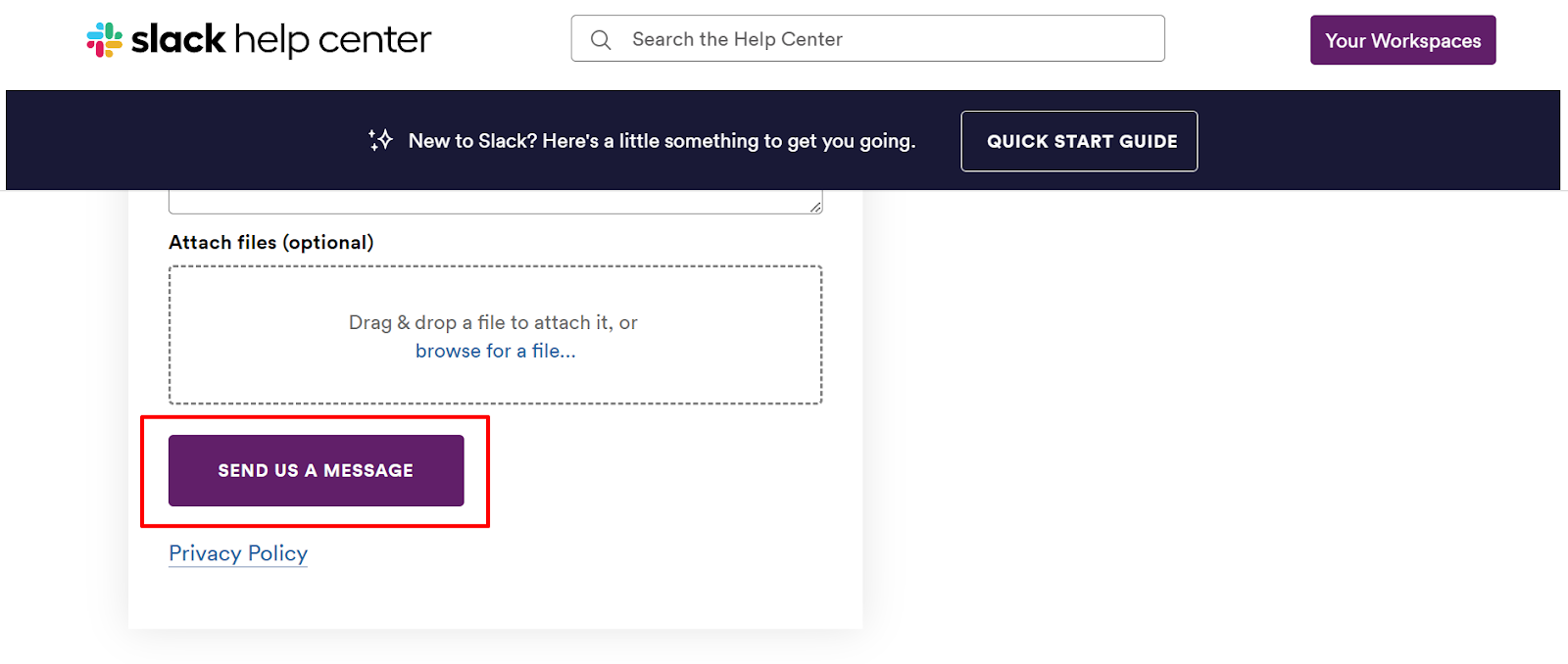
- Then, you will see this message on the next page.
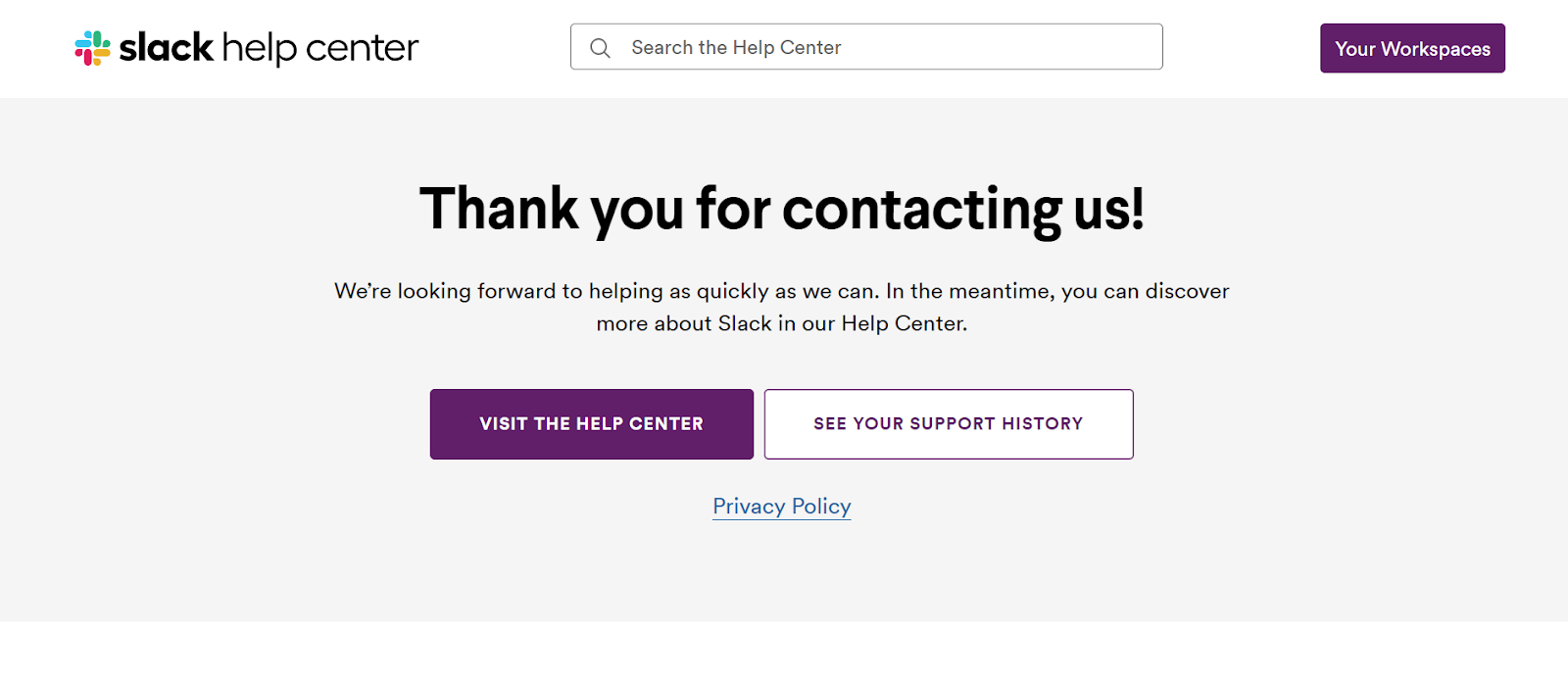
- Deactivating your account qualifies it for deletion. However, this will not take place instantly.
- While deactivation causes deletion, some workspaces may require an additional request to the owner to delete your data completely. This is to ensure compliance with data privacy regulations such as GDPR and CCPA.
- To remove your data, simply fill out this form and then click on the Submit button.
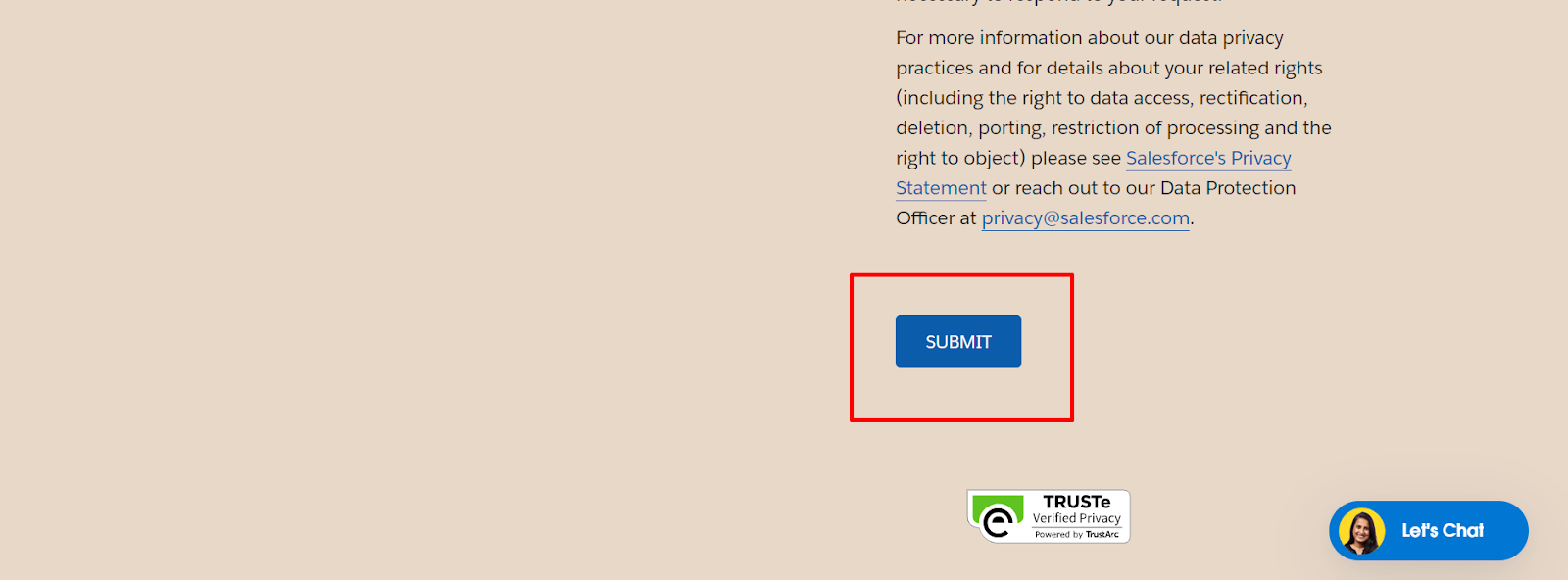
That's it; you can delete your data and deactivate your account from Slack.
Important Things to Consider Before Deleting Data from Slack
Here are some essential factors to consider before removing your data from Slack:
Irreversible Action
- Removing your data from Slack is irreversible.
- There is no "undo" button or recycling bin.
- You will be unable to access your messages, files, or previous edits once it has been deleted.
Download Your Data
- If you think you'll require access to some of your Slack data in the future, try downloading it before deleting it.
- You can save messages, files, and even highlights.
Impact On the Workplace
- Deleting your data can have an impact on others in the workplace, particularly if you have shared sensitive information or files.
- Notifying coworkers ahead of time and ensuring they have all of the necessary information is a good idea.
Consider Alternatives
- Rather than cancelling your entire account, consider leaving certain workspaces that you no longer use.
- In this manner, you can maintain access to important information in active workspaces.
Compliance with Rules
- Workspace owners should be aware that various data protection rules, such as GDPR and CCPA, can require special protocols for deleting member data.
- Make sure to follow these guidelines.
What Is Adobe?
Adobe Systems, Inc. is the world's leading multimedia software firm. Its products are largely utilised by professional designers and editors.
Adobe, launched in 1982 by Dr. John Warnock, established the path for the desktop publishing business with PostScript fonts.
PostScript, which was initially designed for the Mac, quickly became the industry standard for graphic designers and printers, too.
Adobe expanded its product offerings with the 1995 acquisitions of PageMaker and FrameMaker desktop publishing applications.
Why Is It Important to Delete Your Data from Adobe?
The decision to delete your data from Adobe is based on your priorities. Here are some of the reasons you might think about it:
Decreased Data Collection
- Once you delete your data, Adobe reduces the amount of data it saves about you.
- This may be appealing if you have concerns about extensive data collection strategies.
Minimise the Risk of Data Breach
- Despite Adobe's security precautions, data breaches can occur.
- Deleting your data mitigates the possible consequences of such an event.
No More Using Adobe Products
- If you have quit using Adobe products and services, they do not need to keep your data.
How Does Adobe Use Your Data?
Adobe uses the data you provide as well as details about how you use their products to customise your experience, improve their products, and perhaps target advertising.
While this can be useful for personalization, there is always a chance of data breaches and the possibility that your anonymized data will be used for more general advertising purposes.
Learn how Adobe uses your data by reading users' discussions:
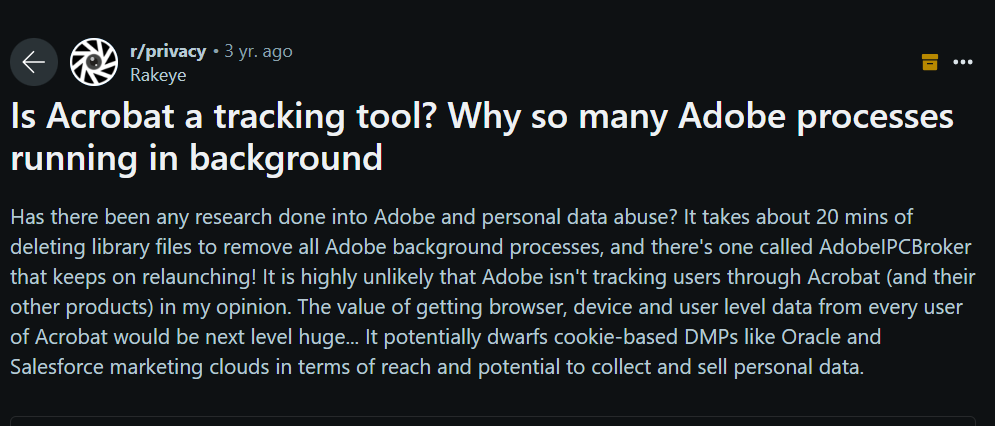
How to Delete Your Data from Adobe
Delete Files Permanently from the Creative Cloud
- First of all, go to adobe.com and sign in to your account.
- Navigate to the Files tab in the left sidebar, then select Deleted.
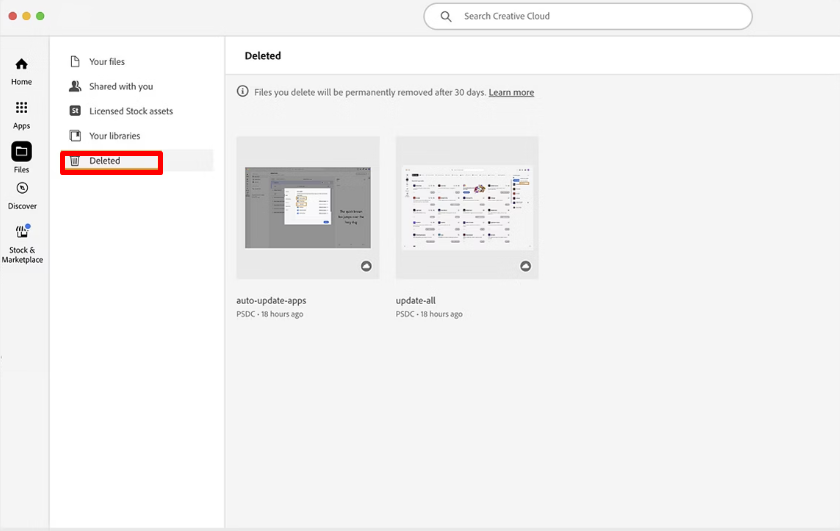
- Choose the files or folders you want to remove from the cloud permanently, then click Delete Permanently.
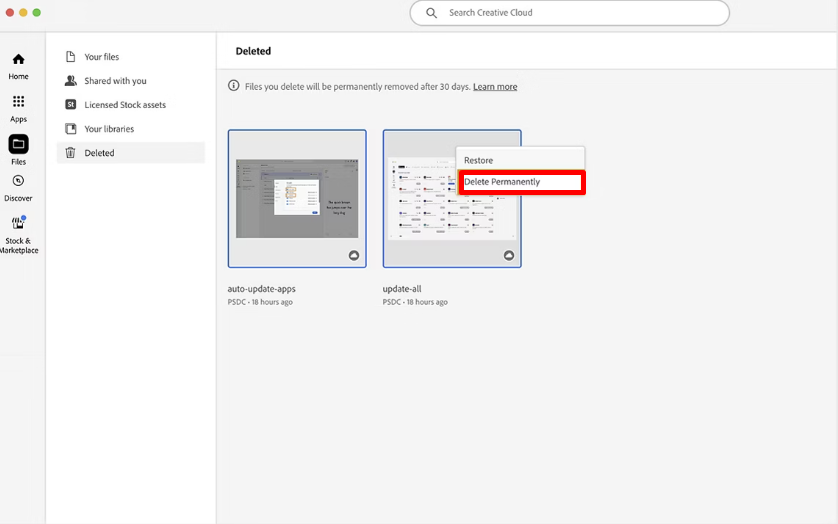
- When you receive the confirmation notification, select Delete Permanently.
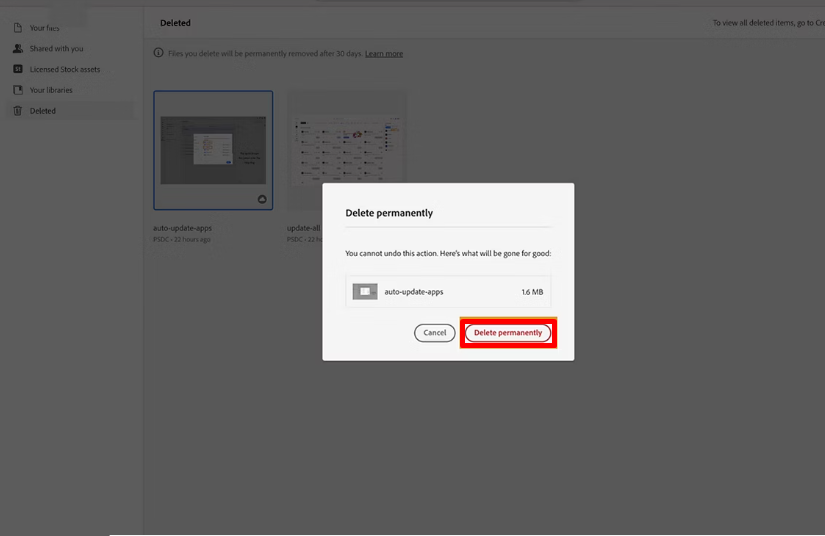
Delete Photographs Permanently from Lightroom Storage
- Sign in to Lightroom over the web.
- Select Deleted from the left sidebar.
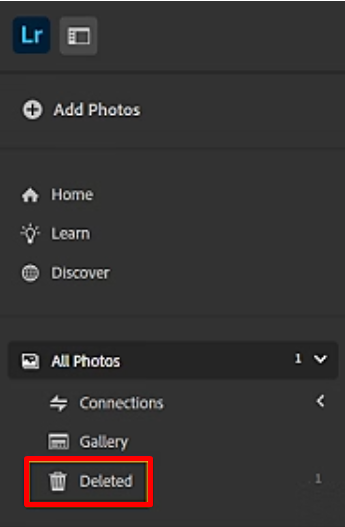
- Select which files you want to permanently remove from the cloud, and then click on the Trash icon.
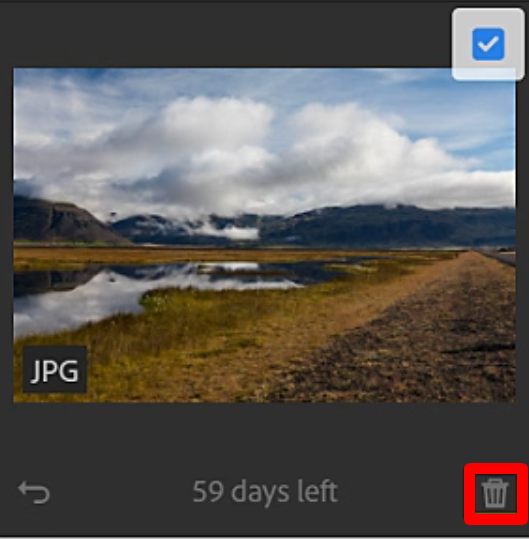
Delete Files Permanently from the Document Cloud
- Sign in to Acrobat Web.
- Select the files that you want to delete and select Delete from the list of available options on the right.
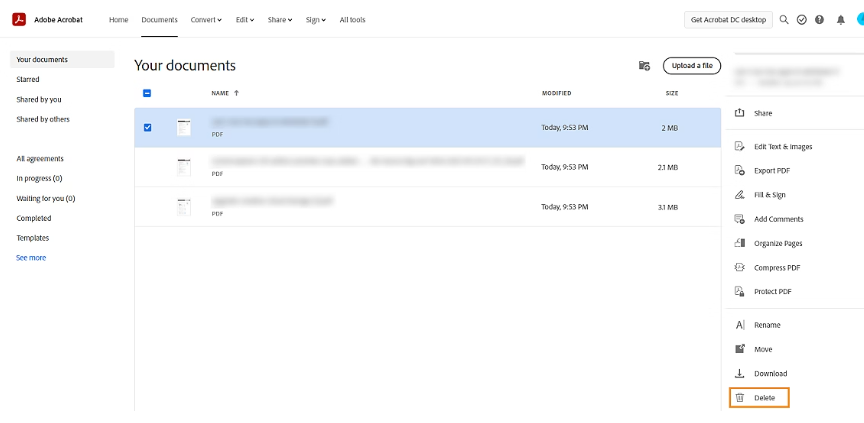
- After that click on the Delete button from the popup window.
Delete Files Permanently with Adobe Express
- Sign in to Adobe Express.
- Click over the file you wish to delete, click the icon, and then click Delete from the options that appear.
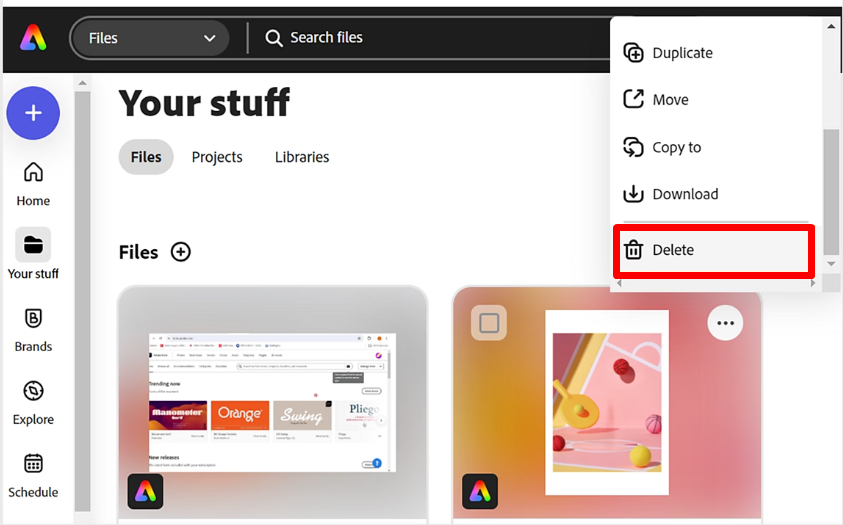
- Then click the Delete button again from the popup window.
Important Things to Consider Before Deleting Your Data from Adobe
Here are the most crucial things to consider before removing the data from Adobe:
Backup Critical Files
- Deleting your account permanently deletes all data stored with Adobe.
- This includes files, images, videos, Adobe Stock assets, and project information.
- Before proceeding, ensure that you have local backups of all crucial files.
Cancel Ongoing Subscriptions
- You cannot remove your account if you have any ongoing subscriptions.
- Cancel existing subscriptions (Creative Cloud, Acrobat, etc.) to avoid future charges.
Gradual Deletion
- Because of Adobe's data retention policy, deletion may take time.
- There will be a waiting period before your information is completely wiped.
No Control Over Anonymised Data
- While your private data is removed, Adobe may continue using anonymized data for analytics.
Loss of Features
- Deleting your account may limit your access to some Adobe features.
- Consider whether these features are crucial to your workflow.
Reduce Data Collecting
- If complete removal is not required, you could consider limiting data collection within your account settings.
What Is Google?
Google, formerly called BackRub, is a search engine founded in 1996 by Sergey Brin and Larry Page. It was an academic project at Stanford University that was used to find files on the Internet.
Larry and Sergey later decided that the name of their search engine had to change, so they chose Google, inspired by the term googol. The corporation has its headquarters in Mountain View, California.
Why Is It Important to Delete Your Data from Google?
Deleting your data from Google is based on how important privacy is to you. Here's an overview of the benefits and drawbacks to help you decide:
Enhanced Safety
- Delete your information to minimise what Google knows about you.
- It involves search history, location, and YouTube viewing history.
Lower Risk of Data Breaches
- Large organisations, such as Google, are prime targets for cybercriminals.
- If your data is kept on Google's servers, it may be compromised during a data breach.
- Deleting your data may assist in mitigating this risk.
Fewer Personalised Experiences
- Google customises your experience (search results, recommendations) based on your information.
- Deleting it can make these functions less helpful.
Difficulties of Data Deletion
- Deleting data from Google can be both time-consuming and inconvenient.
- Google provides a method to remove your data, which might be hard to find and use.
- Furthermore, removing your data may disable specific Google product features you rely on.
How Does Google Use Your Data?
Google uses lots of information about you to tailor your experience and target advertisements.
This includes your search history, location, YouTube viewing history, and even Gmail content. Google utilises this information to customise your experience (search, videos, and advertisements).
This brings up security and privacy concerns. Data breaches are a threat, and Google's data policies may not be completely transparent.
Learn how Google uses your information by reading reviews:
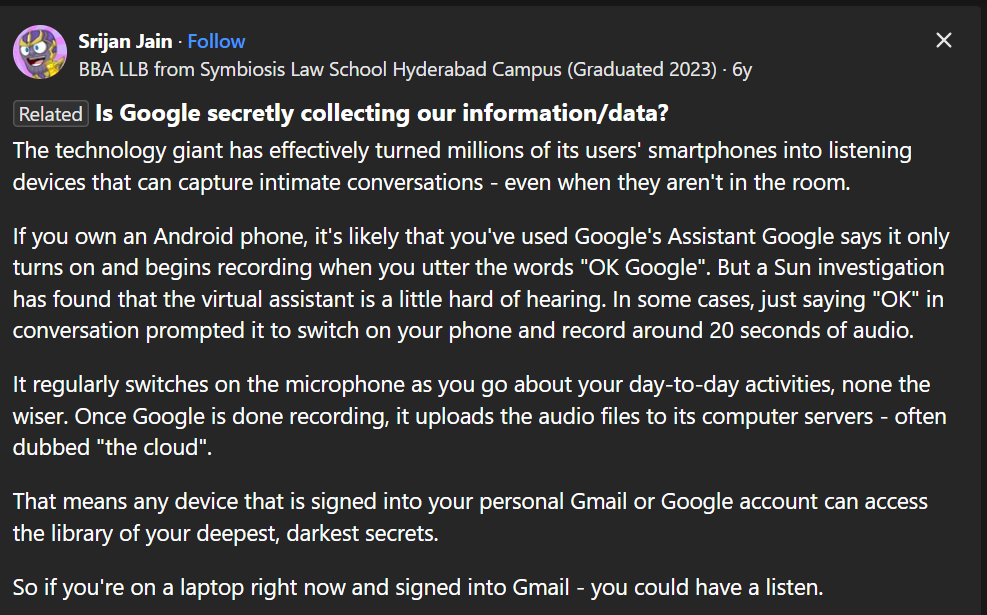
How to Delete Data from Google
- You must submit a removal request if you want Google to delete information from its search results.
- Visit Google's Request to Remove Personal Information page and select Remove information displayed in Google Search.
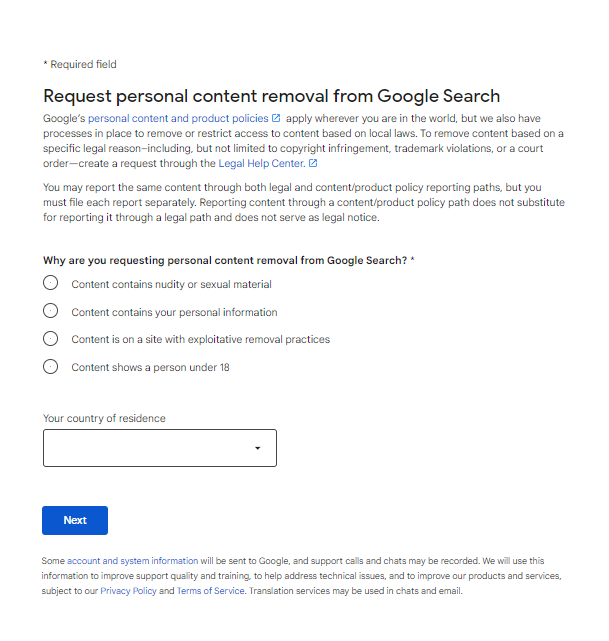
- When requesting removal from Google, specify whether the information is on a website or in search results.
- Based on your selection, follow specific directions, providing the URL for deleted website content or the link address for images.
- After filing a removal request, Google evaluates the content to determine whether it fits the removal requirements.
- Information in news articles or public records on government websites may be retained.
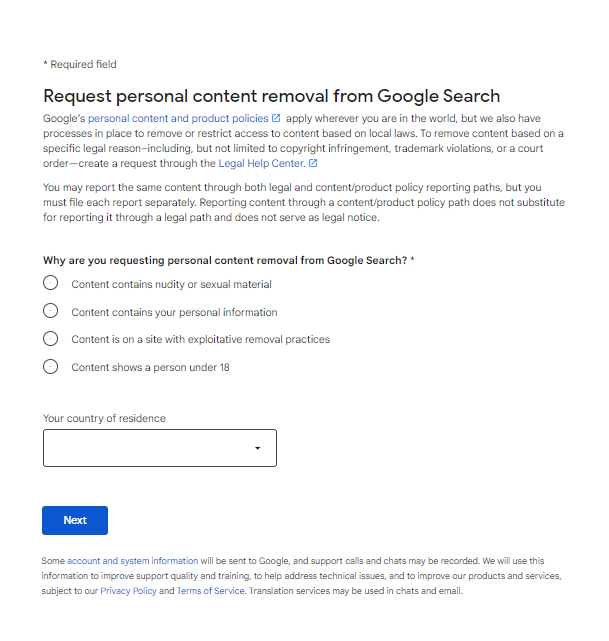
- You'll receive an automatic email verifying that Google received your request.
- If more information is required, you will also be given precise instructions.
- At last, you will receive an alert regarding any activity that has been done.
Essential Things to Consider Before Deleting Your Data from Google
Here are some essential factors to consider before deleting your data from Google:
Alternatives to Deletion
- Rather than deleting everything, think about changing privacy settings to minimise data collecting.
Data Backups
- When deleting any crucial information (documents, images), make sure you have backups stored in Google Drive.
Accounts Restoration
- Update the account recovery details in case you need to recover access to your Google account following data loss.
Is AI a Safe Platform?
While AI has undeniable advantages for firms like OpenAI, Slack, Adobe, and Google, you should be aware of certain safety concerns.
These platforms handle huge numbers of data, making them a great target for hackers.
- The fact that 77% of firms have encountered AI breaches in the last year highlights this vulnerability.
- Security concerns range from breaches during development to exploitation of generated outputs by hackers who get access.
- AI can be used to simplify hacking activities, increasing attack efficiency and danger.
- AI-powered bots were used in a DDoS attack against TaskRabbit, which compromised millions of data.
- According to the company's AI analysts, an AI-enabled API was used to breach T-Mobile, disclosing 37 million sensitive user data.
According to AI security specialist Kevin Mitnick,
"Any of us could experience a data breach, especially one that uses AI."
Read people's reviews about safety concerns regarding AI to get a better understanding:

However, PurePrivacy can help reduce the risks associated with AI by providing an online service for managing social media privacy settings.
The app recognizes risky permissions granted to social media apps and makes suggestions to improve privacy.
PurePrivacy also includes features to manage shared material and remove search history, which limits the data available to AI algorithms that could be used for illicit activities.
Frequently Asked Questions (FAQs)
-
Can data be removed from AI?

One clear way to remove the influence of a specific type of data, whether it is incorrect, biassed, protected, harmful, or sensitive in some other way, is to remove it from the training data and then retrain the model.
-
Can we believe in AI?

Humans are usually predictable to other humans since we share the same experiences, but this is not true for artificial intelligence, which was built by humans. If trustworthiness contains essentially predictable and normative features, AI fundamentally lacks the characteristics that would make it worthy of trust.
-
Is there a danger in AI?

AI may unintentionally spread biases resulting from training data or systematic algorithms. Data ethics is still growing, but there is a risk that AI systems will produce biassed results, potentially leaving a corporation open to litigation, compliance challenges, and privacy concerns.
-
Can AI obtain your personal information?

Generative AI techniques trained on scraped internet content can be associated with personal information about individuals as well as relational data about their relatives and friends. This information enables spear-phishing—the purposeful targeting of individuals with the intent of identity theft or fraud.
Reclaim Optimal Privacy by Deleting Data from AI and Tech Giants
In short, while AI companies such as OpenAI, Slack, Adobe, and Google provide incredible benefits, it is critical to be mindful of the risks that are involved.
These platforms handle vast amounts of data, which makes them a perfect fit for hackers. You can take precautions to reduce your risk.
This blog explains how to get your data removed from significant AI and tech companies.
PurePrivacy can also help manage social media privacy and minimise the amount of data available to AI systems.
Remember, you always have control over how much data you share and how it is utilised.
